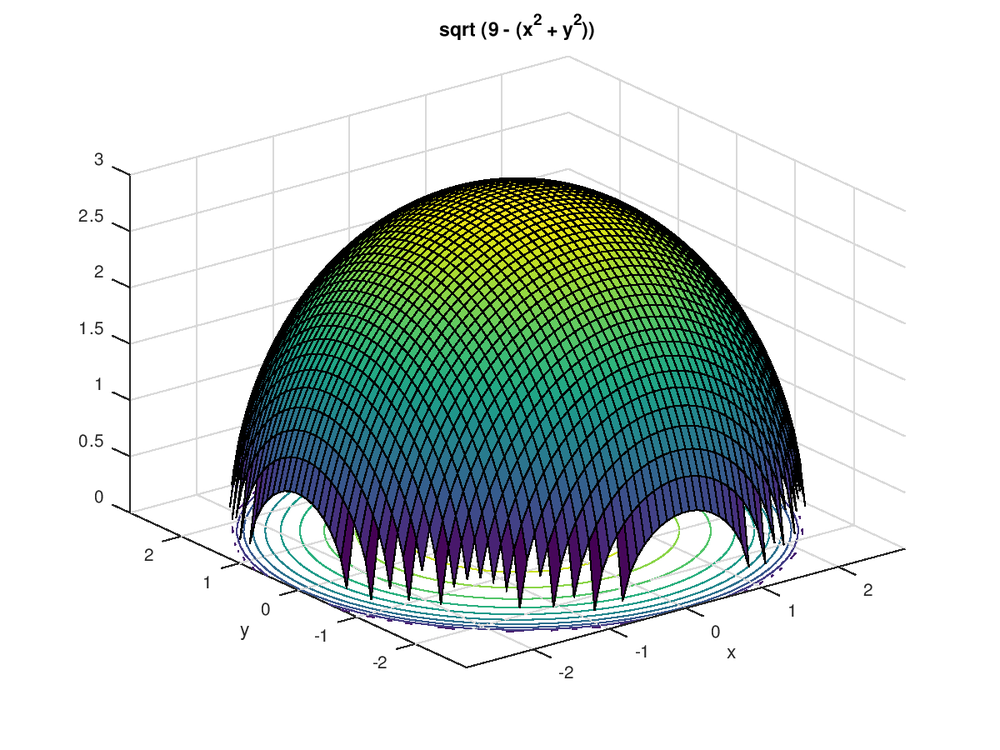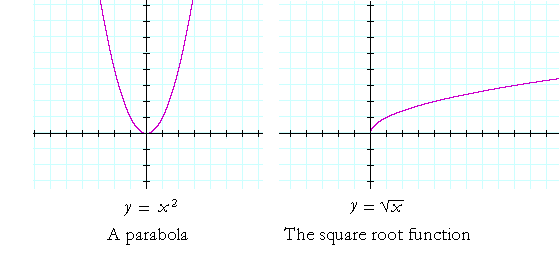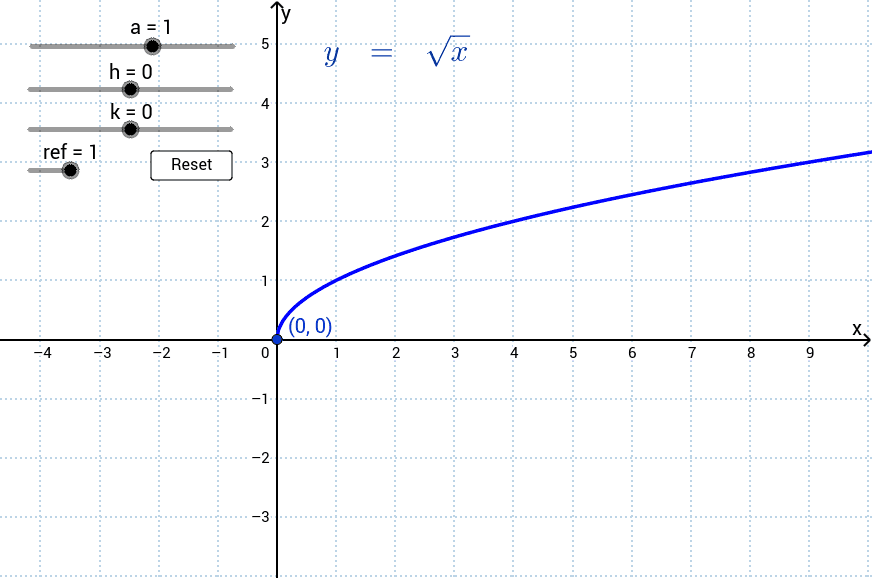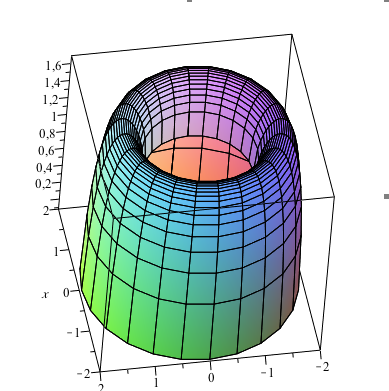√70以上 Sqrt(x^2+y^2) Graph 246844-3d Graph 1.2+(sqrt(1 Sqrt(x^2+y^2 2)))
Specify Method New Chain Rule;All equations of the form a x 2 b x c = 0 can be solved using the quadratic formula 2 a − b ± b 2 − 4 a c The quadratic formula gives two solutions, one when ± is addition and one when it is subtraction y^ {2}\left (2\sqrt {x}1\right)yx^ {2}x=0 − y 2 ( 2 ∣ x ∣ 1) y − x 2 − ∣ x ∣ = 0It cannot be done Suppose to the contrary that it can be done We will derive a contradiction Suppose that \frac{x^2}{\sqrt{x^2y^2}}=f(x)g(y) for some functions f and g

Draw The Graph Of Y Sqrt X 2 1
3d graph 1.2+(sqrt(1 sqrt(x^2+y^2 2)))
3d graph 1.2+(sqrt(1 sqrt(x^2+y^2 2)))-Intuitively, if I look at the derivatives, $\frac{x}{\sqrt{x^2y^2}}$, $\frac{y}{\sqrt{x^2y^2}}$, they are increasing in every positive Stack Exchange Network Stack Exchange network consists of 178 Q&A communities including Stack Overflow , the largest, most trusted online community for developers to learn, share their knowledge, and buildProblem 6 Easy Difficulty The graph of $ y = \sqrt{3x x^2} $ is given Use transformations to create a function whose graph is as shown




Find The Surface Area Of The Portion Of The Cone Z Sqrt X 2 Y 2 That Lies Below The Plane Z 2 Study Com
Partial derivative of sqrt (x^2y^2) \square!Graph sqrt(x^2 y^2) Natural Language;Algebra Graph x^2y^2=1 x2 y2 = 1 x 2 y 2 = 1 This is the form of a circle Use this form to determine the center and radius of the circle (x−h)2 (y−k)2 = r2 ( x h) 2 ( y k) 2 = r 2 Match the values in this circle to those of the standard form The variable r r represents the radius of the circle, h h represents the xoffset from the origin, and k k represents the yoffset from origin
See below For the equation y=sqrt(x2) we can graph this starting with an understanding of the graph, sqrtx and adjusting from there Let's take a look at that graph first graph{sqrtx 1, 10, 3, 5} The graph of sqrtx starts at x=0, y=0 (since we're graphing in real numbers on the x and y axis, the value under the square root sign can't be negative) then passesVIDEO ANSWER All right So for this problem, doing the same thing we're discussing the graph about function in this gonna be And except why? As for your request in the comments, one can write the function as sqrt(u*v), where u=xy and v=xy Then x=(uv)/2 and y=(uv)/2 Since the variables are just placeholders in a parametric plot, we can rename u and v to x and y, respectively, and arrive at
Sqrt (x) WolframAlpha Volume of a cylinder? The graph of $x = y^2$ contains points $(x,y)$ with $y$ negative while the graph of $y = \sqrt{x}$ has points $(x,y)$ with $y \geq 0$ Viewed as sets of points, they do not have the same elements which are ordered pairs ,hence the graphs are different Hello, Let Sigma the surface of your function F it's a surface of revolution because F(x,y) = f(r) where r = sqrt(x^2y^2) Precisely, f(r) = sqrt(r^21) ln(4r^2) First, plot the curve of f r \mapsto sqrt(r^2 1) ln(4r^2) You get Now, turn this curve around zaxes in 3Dspace You get the surface Sigma




Draw The Graph Of The Surface Given By Z 1 2 Sqrt X 2 Y 2 Study Com




Sketch The Graph Of F X Y Sqrt 1 X 2 Y 2 State The Domain And Range Of The Function Study Com
The graph of y = a×sqrt (xh) k, showing transformations and a common alternative form of the equation for the horizontally reflected case, where appropriateConsider these two questions Solve for y in the equation y^2 = 4 Evaluate \sqrt{4} These questions are related, but they are not the sameUnlock StepbyStep x^2 (ysqrt (x^2))^2=1 Natural Language Math Input Use Math Input Mode to directly enter textbook math notation Try it × Extended Keyboard Examples




Draw The Graph Of Y Sqrt X 2 1




Which Is The Graph Of Y 3 Sqrt X 1 2 Brainly Com
Because the's square root of for X squared plus y squared Okay, so thePiece of cake Unlock StepbyStep Natural Language Math Input Use Math Input Mode to directly enter textbook math notationNew Google easter egg (12) a real easter egg this time type in 12(sqrt(1(sqrt(x^2y^2))^2) 1 x^2y^2) * (sin (10 * (x*3y/57))1/4) from




Sketch The Graph Of F X Y Square Root 4 X 2 Y 2 Study Com




Consider Z Sqrt X 2 Y 2 Give The Domain And Range Draw The Zx And Zy Traces In Two Homeworklib
The graph of straight line `y = sqrt(3)x 2sqrt(3)` is A B C D Given a process on `P T` diagram Select the corresponding graph(s)for the given processSqrt (x)sqrt (y)=sqrt (xy) \square! $\begingroup$ it's not quite correct to call these functions without specifying a domain and codomain and taking a bit more care, ie defining the curves as the image set in $\mathbb{R}^2$ of $\{x,y \in \mathbb{R} \mid y^2 = x\}$ That aside, this has nothing to do with the graphing of functions but instead the lack of injectivity when you square something without




Does Sqrt X 2 Y 2 X Y Brilliant Math Science Wiki



Hyperbola
The graph is an arc of parabola with line bissector (y=x) as its axis of symmetry Here is why Setting $\sqrt{x}=t \iff x=t^2$, we have $y=1\sqrt{x}=1t \iff y^2=t^22t1$ Using rotation by $\pi/4$ combined with homothety with ratio $\sqrt{2}$ Given #" "x^2y^2=r^2" ">" "x^2y^2 =4# Subtract #x^2# from both sides giving #" "y^2=4x^2# Take the square root of both sides #" "y=sqrt(4x^2)# Now write it as #" "y=sqrt(4x^2)# '~~~~~ Calculate and plot a series of points using first the positive version of this equation then repeat using the negative sideMath Input Use Math Input Mode to directly enter textbook math notation Try it



Lesson Finding Inverse




Implicit Differentiation
To graph the XY plane you set Z = 0 and plot the function as you normally would, so $$z = \sqrt(x^2 y^2 1) == 0 = \sqrt(x^2 y^2 1)$$ $$\text {Therefore} x^2 y^2 = 1$$ is your XY axis graph, which is just a circle of radius 1 centered at the origin Finally, sketch the graph of y = sqrt(x 2 1) by plotting the square root of the y values of the previous graph (y = x 2 1) Ie, instead of plotting (1, 2), plot (1, sqrt(2)) and so on Your final graph will be roughly similar to the graph of y = x 2 1 except that as x gets large (or very negative) the graph has a slant asymptote, whichAnswer to Sketch the graph of f(x,y) = \\sqrt{(4 x^2 y^2)} By signing up, you'll get thousands of stepbystep solutions to your homework




How To Draw Y 2 X 2 Interactive Mathematics




Multivariable Calculus How Do I Graph Z Sqrt X 2 Y 2 1 Without Using Graphing Devices Mathematics Stack Exchange
New Google easter egg (12) a real easter egg this time type in 12(sqrt(1(sqrt(x^2y^2))^2) 1 x^2y^2) * (sin (10 * (x*3y/57))1/4) from 16 tGraph Hide Plot » So for this problem, we're going to be graphing, um, and f of X y function So it's a multi variable function, and this one is going to be the square root of four X squared US White Square So this is the graph that we end up getting on This is what it's called an elliptical cone Um, it's elliptical because we see that has this elliptical




Graph Of Sqrt X Geogebra



Solution I Wont To Kno How To Graph Y The Square Root Of X 2
Subtracting x^ {2} from itself leaves 0 Subtracting x 2 from itself leaves 0 \left (y\sqrt 3 {x}\right)^ {2}=1x^ {2} ( y 3 x ) 2 = 1 − x 2 Take the square root of both sides of the equation Take the square root of both sides of the equation y\sqrt 3 {x}=\sqrt {1Derivative at a point;Extended Keyboard Examples Upload Random




Cylindrical Coordinates Triple Integral Bounded Above By Z 6 X 2 Y 2 And Below By Z Sqrt X 2 Y 2 Mathematics Stack Exchange




Consider The Following Y X 2 Y Sqrt 3 X A Use A Graphing Utility To Graph The Region Bounded By The Graphs Of The Equations B Use The Integration Capabilities
To zoom, use the zoom slider To the left zooms in, to the right zooms out When you let go of the slider it goes back to the middle so you can zoom more You can clickanddrag to move the graph around If you just clickandrelease (without moving), then the spot you clicked on will be the new center To reset the zoom to the original clickSo we had to graph the following function We've got to have the a vehicle fiscal route of expert plus Y squared And this is the basic form of oh, oh the graph and get at X and Y equals to zero This is also going to be zero Going to go up an increase in circles like yes, so might help circles a little bit too big so mm back to it's gonna goGet stepbystep solutions from expert tutors as fast as 1530 minutes Your first 5 questions are on us!




How Do You Graph Square Root Equations Youtube



Graph X 2 Ky 2 25 For Different Values Of K
Z=sqrt (x^2y^2) WolframAlpha Area of a circle?The graph crosses Y axis when x equals 0 substitute x = 0 to sqrt((x 2)/(x 2)) sqrt((1 x)/sqrt(1 x)) $$\sqrt{\frac{1 0}{\sqrt{1}}} \sqrt{ \frac{2}{2}}$$Gradient sqrt(x^2y^2), \at(2,2) Derivatives First Derivative;




A Use A Cas To Draw A Contour Map Of Z Sqrt 9 X 2 Y 2 Quizlet




X Sqrt 4 Y 2 Is Not A Full Semicircle
Get stepbystep solutions from expert tutors as fast as 1530 minutesいろいろ plot x^2 (ysqrt ( x ))^2=1 X^2 (ysqrt (x^2))^2=1 graph Divide 0 0 by 4 4 Multiply − 1 1 by 0 0 Add − 2 2 and 0 0 Substitute the values of a a, d d, and e e into the vertex form a ( x d) 2 e a ( x d) 2 e Set y y equal to the new right side Use the vertex form, y = a ( x − h) 2 k y = a ( x h) 2 k, to determine theYou could use y = x2 with explicit domain 0,∞) as the parent graph graph { (sqrt (x)/sqrt (x))x^2 4767, 523, 06, 44} Reflecting this in the diagonal line y = x we get the graph of y = √x graph {sqrt (x) 4767, 523, 06, 44} George C 1



How Do You Determine The Domain And Range Of The Relation X 2 Y 2 1 And X 2 Y 2 100 I Know It Makes A Circle But I M Just Confused About The Enotes Com




What Is The Difference Between Math Y 2 X Math And Math Y Sqrt X Math Quora
Easy as pi (e) Unlock StepbyStep Natural Language Math Input Use Math Input Mode to directly enter textbook math notationWe have `y= sqrt (x^(2) 2)` or `" "y^(2)= x^(2) 2` or `" "x^(2) y^(2)= 2`, which is a rectangular hyperbola But `" "y= sqrt(x^(2) 2) le 0` So the graph of `y= f(x)` is part of the hyperbola `x^(2)y^(2) =2`, which lies below the xaxis The above is such that x is the independent variable and y the dependant variable Suppose we reversed this Write as sqrt(x2)=y3 Squaring both sides x2=y^26y9 x=y^26y11 If you plotted this then you would have the same graph as y=sqrt(x2)3




How Do You Graph Y Sqrt X 2 2 Socratic




How Do You Graph Y Sqrt X 2 3 Socratic
Trigonometry Graph square root of x^2y^2 √x2 y2 x 2 y 2 Graph Keep in mind, though, that you need to graph y = sqrt(a 2 x 2), not the one you get by squaring both sides They are different #4 GreenPrint 1,196 0 oh it's a circle with a center at the origin but how do I deal with the fact that I'm not graphing y^2 but just yThe penis graph on the other hand, only comes of as childish Sure, it would have been really funny when I was 15 And to be sure, there are plenty of clever penis jokes out there ("The hammer is my penis" comes to mind), but this is not one of them 1 * (x^2(ysqrt(x^2))^2=1) would be a Bob Marley song zinssmeister on prev




Transforming The Square Root Function Video Khan Academy




Which Graph Represents Y 3 Sqrt X 5 Brainly Com
Video Transcript So here we have a function f of X equals the square root of X quit and we are asked to graft dysfunction So let's set up a table of values is that we have X and aftereffects So let's plug in negative 11 square as one square of one is one Let's look in so so square cell square with of zero so blissful You one one square is Free Online Scientific Notation Calculator Solve advanced problems in Physics, Mathematics and Engineering Math Expression Renderer, Plots, Unit Converter, Equation Solver, Complex Numbers, Calculation HistoryY = √x − 2 y = x 2 Find the domain for y = √x −2 y = x 2 so that a list of x x values can be picked to find a list of points, which will help graphing the radical Tap for more steps Set the radicand in √ x − 2 x 2 greater than or equal to 0 0 to find where the expression is




Complex Numbers And Plotting In Matlab



Solution How Would You Graph X 2 Y 2 36 Thanks
The square root keeps us from going above that point z=4 if we manipulate the equation and isolate x 2 y 2 we get x 2 y 2 = 16 z 2 (remember that since we have a square root in our original function, we have to consider it's domain in our graph, meaning z Setting `z=0` in `z=sqrt(x^2y^2)` yields `0=sqrt(x^2y^2)`, or equivalently, `0=x^2y^2`, whose graph is the single point `(0,0)` Thus, the trace in the `xy`plane is the point `(0,0)` To flesh out the rest of the surface, we take parallel crossGraph y=2 square root of x y = 2√x y = 2 x Find the domain for y = 2√x y = 2 x so that a list of x x values can be picked to find a list of points, which will help graphing the radical Tap for more steps Set the radicand in √ x x greater than or equal to 0 0 to find where the expression is defined x ≥ 0 x ≥ 0




Graphing Square Root Functions




14 1 Functions Of Several Variables Mathematics Libretexts
Swap sides so that all variable terms are on the left hand side \sqrt {x1}=y x − 1 = y Square both sides of the equation Square both sides of the equation x1=y^ {2} x − 1 = y 2 Add 1 to both sides of the equation Add 1 to both sides of the equationCalculus Graph x=2 square root of y The domainin termsof are all the values that make the radicandnonnegative To find the radical expressionend point, substitute the value , which is the least value in the domain, into Tap for more steps Replace the variablewith in the expression Simplify the result




Graph 3d Dome In Gnuplot With Sqrt X Function Stack Overflow




Draw The Graph Of Y Sqrt 1 X 2 X



Graphing Square Root Functions




Which Graph Represents Y Sqrtx 4 Brainly Com




Functions How To Plot Z 5 Sqrt X 2 Y 2 0 Le Z Le 5 In Mathematica Mathematics Stack Exchange




How Do You Graph F X Y Sqrt X 2 Y 2 1 Ln 4 X 2 Y 2 Socratic



Untitled Document




Graphs Of Square Root Functions Ck 12 Foundation




Graph Of A Parabola Topics In Precalculus




How Do You Graph Y Sqrt 2 X And How Does It Compare To The Parent Function Socratic




Roses Are Red Violets Are Blue Graph This On A Graphing Calculator And See What It Will Do Y Sqrt 1 Abs X 1 2 Y Acos 1 Abs X 3 14 Randomactsofkindness Ask Fm Rachel Samuels




Solved Evaluate Double Integral D Square Root X 2 Y 2 Da Chegg Com




Multiple Integrals1 Html




Module 11 Semi Circle Y Sqrt R 2 X 2




Grafica Atarinside




Find The Surface Area Of The Portion Of The Cone Z Sqrt X 2 Y 2 That Lies Below The Plane Z 2 Study Com



Solving Equations Algebraically




Fitness Function F3 F X Y X2 Y2 Documentclass 12pt Minimal Download Scientific Diagram




Google Smart Graphing Functionality




Multivariable Calculus How Do I Graph Z Sqrt X 2 Y 2 1 Without Using Graphing Devices Mathematics Stack Exchange



Polar Html




The Gray Curve Is The Graph Of 1 2 Ln 1 1 X The Dashed Curve Is Ps X Download Scientific Diagram




Shifts Of Square Root Functions Read Algebra Ck 12 Foundation




Matlab Spiel Stream Of Consciousness Graphing Learning



How Do I Draw A Graph For This Y Sqrt X2 1 There Seems To Be No Points In Quadrant 2 Why Is This The Thing Is For Every Negative X Enotes Com




Example 4 Graph A Translated Square Root Function Graph Y 2 X Then State The Domain And Range Solution Step 1 Sketch The Graph Of Y 2 X Ppt Download




Surfacesandcontours Html



Is Y Sqrt X 2 1 A Function Quora



Is Y Sqrt X 2 1 A Function Quora




Graphs Of Square Root Functions Ck 12 Foundation



Gnuplot Demo Script Contours Dem



What Is The Graph Of X 2 Y 2 Z 1 2 1 Quora




Grafica Atarinside




Graph Y Square Root Of X 2 Square Root Of X 6 4 Displaystyle Y Sqrt X 2 Sqrt X 6 4 Snapsolve



Solution What Point Is The Intersection Of The Graphs Of X 2 Y 2 5 And 2x 2 Y 2 22




Surfaces Part 2




R Sqrt X 2 Y 2 Z 10 Sin R R Youtube




Horiziontal Translation Of Square Root Graphs Definition Expii




Transformations Of The Graph Y Sqrt X Geogebra




Example 4 Graph A Translated Square Root Function Graph Y 2 X Then State The Domain And Range Solution Step 1 Sketch The Graph Of Y 2 X Ppt Download



What Is The Volume Of The Solid Generated When The Region Bounded By The Graph Of X Sqrt Y 2 Know It Info




Implicit Differentiation




How To Graph Square Root Of A 2 X 2 Examples Youtube




Horiziontal Translation Of Square Root Graphs Definition Expii




3d Graphing Calculator On Google Connectwww Com




Solved The Graph Of Y Square Root 2x X 2 Is Given Use Chegg Com




Answers To The Review Problems For The First Exam 251 05 10 In Spring 06



2




How Do You Graph Y Sqrt X 2 3 Socratic




Solved Use Traces To Sketch The Graph Of The Function F X Chegg Com



L2d2ii Html




File Inverse Square Graph Png Wikimedia Commons




View Question X 2 Y 2 36 Graph Equation Describe The Graph And Its Lines Of Symmetry



1



Solving Equations Algebraically




Graphing Square Root Functions




Graphing Square Root Functions




Draw The Graph Of Y X Sqrt X X Where Denotes The Greate




11s Quick Graph Y Sqrt 49 X 2 Youtube



Gnuplot Demo Script Singulr Dem



1




Given The Cone S 1 Z Sqrt X 2 Y 2 And The Hemisphere S 2 Z Sqrt 2 X 2 Y 2 A Find The Curve Of Intersection Of These Surfaces B Using Cylindrical




Solved Let F X Y Y X Sqrt X2 Y2 Set Up But Do Not Chegg Com




Transforming The Square Root Function Video Khan Academy




Answered Consider The Region Bounded By The Bartleby




Graphing Square Root Functions




Solved Graph The Functions F X Y Sqrt X 2 Y 2 F X Y E Sqrt X 2 Y 2 F X Y Ln Sqrt X 2 Y 2 F X Y Sin Left Sqrt X 2 Y 2 Right And F X Y Frac 1 Sqrt X 2 Y 2 In General If G Is A Function Of One Variable



Hyperbola Equation




How Do You Graph F X Y Sqrt X 2 Y 2 1 Ln 4 X 2 Y 2 Socratic




Multivariable Calculus How Do I Graph Z Sqrt X 2 Y 2 1 Without Using Graphing Devices Mathematics Stack Exchange




Find The Volume Between The Cone Z Sqrt X 2 Y 2 And The Sphere X 2 Y 2 Z 2 4 Study Com




Solved Sketch The Graph Of F X Y Sqrt 1 X 2 Y 2 State The Chegg Com




Consider Z Sqrt X 2 Y 2 Give The Domain And Range Draw The Zx And Zy Traces In Two Homeworklib




6 7 Maxima Minima Problems Mathematics Libretexts
コメント
コメントを投稿